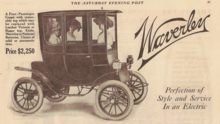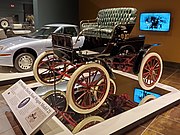Pope-Waverley
 The Silent Waverley | |
| Formerly | International Motor Car Company |
|---|---|
| Industry | Automotive |
| Founded | 1898 |
| Defunct | 1916 |
| Fate | Closed |
| Headquarters | Indianapolis, Indiana, |
| Products | Electric automobiles |
| Brands | Waverley, Pope-Waverley |

Pope-Waverley was one of the marques of the Pope Motor Car Company founded by Albert Augustus Pope and was a manufacturer of Brass Era electric automobiles in Indianapolis, Indiana. From 1908 until production ceased in 1914 they became independent again as the Waverley Company.[1][2]
History[edit]
The company was originally formed as the Indiana Bicycle Company in 1898, changing to the American Bicycle Company in 1900. In 1901, it became the International Motor Car Company, before joining the Pope group as the Waverley Department of Pope Motor Car Company in 1904. Originally a small runabout, the Waverley grew to include 4 seats by 1902. When the Pope empire was foundering in 1908, Indianapolis businessmen rescued the Pope-Waverley and established a new Waverley Company to continue production. From 1912, the Waverley had a hood to resemble a gasoline car. This was called the Sheltered Roaster but it later became the Model 90. Front Drive and Rear Drive model designations were used based on the drivers seating position.
Waverley Company ceased production in 1916.[1][2]
Models[edit]
The 1904 Pope-Waverley Chelsea was a runabout model. It could seat 2 passengers and sold for US$1100. The single electric motor was situated at the rear of the car, and produced 3 hp (2.2 kW). The car used 30 batteries.[1]
The 1904 Pope-Waverley Road Wagon was a smaller wagon model. It could seat 2 passengers with an open box at the rear for cargo and sold for US$850. The single electric motor was situated at the rear of the car and produced 3 hp (2.2 kW). The car used a 24-cell battery and could travel at 5 or 15 mph (8.0 or 24.1 km/h).
The 1904 Pope-Waverley Edison Battery Wagon was a runabout model with 48-cell Edison batteries. It could seat 2 passengers and sold for US$2250. The electric motor was situated at the rear of the car.
The 1904 Pope-Waverley Tonneau was a tonneau model. It could seat 5 passengers and sold for US$1800. Twin electric motors were situated at the rear of the car, producing 3 hp (2.2 kW) each with a special 12 hp (8.9 kW) overload mode. The armored wood-framed car used 40 batteries and could reach 15 mph (24 km/h).
Gallery[edit]
-
1901 Harrod's Waverley Electric
-
1903 Waverley Electric Model 21
-
1905 Pope-Waverly Electric
-
1907 Pope-Waverley Model 60C
-
1912 Waverley in American Homes and Gardens Magazine
See also[edit]
- Photo of ca. 1900 Waverly driven by Swan Turnblad at the Minnesota Historical Society.
- Frank Leslie's Popular Monthly (January, 1904)
- Pope-Waverly at ConceptCarz
- Video showcasing a 1901 Waverley Model 22
References[edit]
- ^ a b c Kimes, Beverly Rae; Clark Jr., Henry Austin (1996). Standard Catalog of American Cars 1805-1942 (3rd ed.). Krause Publications. ISBN 978-0-87341-428-9.
- ^ a b Georgano, Nick (2001). The Beaulieu Encyclopedia of the Automobile (3 vol. ed.). Fitzroy Dearborn Publishers. ISBN 1-57958-293-1.
- Electric vehicles introduced in the 20th century
- Defunct motor vehicle manufacturers of the United States
- Motor vehicle manufacturers based in Indiana
- Defunct companies based in Indiana
- Electric vehicle manufacturers of the United States
- Electric vehicles
- Veteran vehicles
- Brass Era vehicles
- 1890s cars
- 1900s cars
- 1910s cars
- Cars introduced in 1898
- Vehicle manufacturing companies established in 1898
- Vehicle manufacturing companies disestablished in 1914





